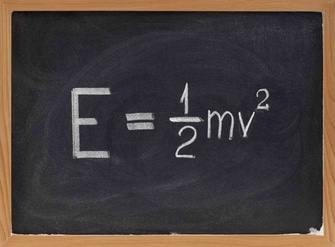Kinetic energy can never be negative. It is always greater than or equal to zero.
The kinetic energy of a moving object equals one-half the product of its mass and the square of its velocity.
Since the mass of an object can never be zero, the square of velocity makes the answer positive.
Therefore, kinetic energy can never be negative.
Kinetic energy is usually represented by the symbol EK or the abbreviation K.E.

Table of Contents
Can Kinetic Energy be Negative?
A moving object’s kinetic energy is equal to half of the product of its mass and the square of its velocity.
Because an object’s mass can never be zero and the square of velocity is positive, the answer is positive.
Therefore, the answer to the question “Can kinetic energy be negative?” is no.
In addition, kinetic energy is the energy possessed by a body due to its motion.
The greater the speed and mass of the moving body, the greater its K.E.
The word “kinetic” comes from the word “kinesis,” which means motion.
Units of Kinetic Energy
- Joules (MKS system).
- 1 erg (CGS system, 1 erg = 10-7Joules).
- electron volt (atomic/subatomic scale).

Kinetic Energy (Key Points)
- The energy possessed by the body due to its motion.
- The unit is joule (kg.m2/sec2).
- directly proportional to the velocity of the object squared. This means that when the velocity of an object doubles, its K.E quadruples.
- When K.E is directly proportional to the mass of the moving object, when the mass of the object doubles, K.E also gets doubled.
- A scalar quantity is completely described by magnitude alone.
Kinetic Energy Types
Translation K.E
Translational K.E = (1/2) (mass) (velocity) 2.
Mass is the amount of matter contained within an object, and velocity is the speed of a moving object in a particular direction.
Rotational K.E
Rotational K.E = (1/2) (Moment of Inertia) (angular velocity) 2.
The moment of inertia is the angular mass or rotational inertia of a rigid body, and angular velocity is a vector measure of rotation rate.
Types of Kinetic Energy
There are five main types of K.E:
- Radiant energy (refers to the energy that travels by waves or particles)
- Thermal energy (refers to the energy among the atoms and molecules in an object.)
- Sound energy deals with the energy caused by vibrations.)
- Electrical energy (related to the energy caused by the flow of negatively charged electrons around a circuit.)
- Mechanical energy (refers to the energy associated with the mechanical movement of an object.)
Kinetic Energy Definitions in Simple Words
- Kinetic energy is defined as the energy possessed by a body by virtue of its motion.
- The translational K.E of a body is equal to one-half the product of its mass, m, and the square of its velocity, v, or (1/2) mv2.
- The rotational K.E of a body is equal to one-half the product of its moment of inertia, I, and the square of its angular velocity, ω, or (1/2)Iω2.
What is Work?
“Work” is a force acting on an object in the direction of motion.
It is the product of force Force (F) and displacement (S) in the direction of the force.
It is a scalar quantity, and its unit is the joule.
Work done = force x displacement.
Please refer to the full article“Can work be negative?”.
What is 1 Joule?
A Joule is the amount of work done when a force of 1 Newton is applied over a distance of 1 meter.
Joule = N.M
Joule= kg*m2/sec2
Derivation of Equation of Kinetic Energy
Consider a body of mass “m” moving with velocity “v” on a rough surface.
The body stops after moving through a distance “S” due to frictional force on it.
A body possesses K.E and is capable of doing work against an opposing force F until it stops and loses all of its K.E. In this case, K.E equals the work done by the body.
The initial velocity (vi) of the body is v and the final velocity (vf) is zero.
K.E=Work = FS
F=ma and a= -F/m (acceleration is negative as motion is opposed)
2aS =vf2-vi2 (Newton law of motion)
2(-F/m)S= (0)2-(v)2
-2FS/m=-v2
FS =(1/2)(m)v2 = K.E
Quick Links
- Difference Between Kinetic and Potential Energy.
- Instantaneous Velocity| Easy Key Points
- Mechanical Energy| 7 Easy Daily Life Examples
- Room Temperature| Comfortable Temperature
Can Velocity Be Negative?
Since velocity is a vector quantity, it can be negative. A positive velocity denotes that the object is traveling in the positive direction as defined by the coordinate system, whereas a negative velocity denotes that the object is moving in the opposite direction. Simply said, when velocity turns negative, it is the speed in the opposite direction.
To get more insight into the topic, please refer to the article “can velocity be negative?“
Daily Life Examples of Kinetic Energy
Some examples of kinetic energy in daily life are listed below:
- As a car moves, it possesses kinetic energy due to its motion.
- When you throw a ball, it gains kinetic energy as it moves through the air.
- When you run, your body gains kinetic energy due to its motion.
- As you ride a skateboard, it gains kinetic energy due to its motion.
- As you swing back and forth on a swing, your body gains kinetic energy.
- When you bounce a basketball, it gains kinetic energy as it moves up and down.
- When you shoot a basketball, it gains kinetic energy as it moves toward the hoop.
- Roller coasters rely on kinetic energy to thrill riders as they go down steep drops and through loops.
- Wind turbines generate electricity by using the kinetic energy of wind to spin their blades.
- Waves in the ocean possess kinetic energy due to their motion.
Example problems
Example 1: Find the K.E of a plane with a mass of 20 tons, moving with a velocity of 500 m/sec.
Mass of plane = 20 Tonnes =20000 kg.
Velocity = 500 m/sec.
K.E = (1/2)(mass)(velocity)2
K.E = (0.5)(20000 kg)(500 m/sec)2
=2500 MJ
Example 2: Find the K.E of an object of two kilograms moving at a speed of one meter per second.
Mass=2kg; velocity = 1m/sec.
K.E = (0.5)(2 kg)(1 m/sec)2.
K.E = 1 Joule
Example 3: An object of mass 500g strikes the ground with a velocity of -20 m/sec. How much is the K.E of the object at the time it strikes the ground? Can K.E be negative in this case?
Mass = 500 g = 0.5 kg.
Velocity = -20 m/sec.
K.E = (1/2)(0.5 kg)(-20 m/sec)2
K.E=100 kg m2/sec2 = 100 J (K.E is positive).
Example 4: A car weighing 10 kN has a speed of 100 km/sec. Find its K.E.
Weight of care = 10 kN = 10,000 N.
Weight = (mass) (gravity).
10000N = (mass)(9.8 m/sec2)
mass=(10000N)/(9.8 m/sec2)
The mass of a car in kg = 1020.40 kg.
Speed of car = 100 km/sec = 100000 m/sec
K.E =(1/2)(mass of car)(speed of the car)
K.E = (1/2)(1020.40 kg)(100000 m/sec) 2
K.E = 51.02 MJ
Related Topics
| Centripetal Acceleration| 9 Easy Examples | Can Work Be Negative?| Easy Explanation |
| Mass vs Weight| Easy Explanation | Can Force be Negative?| Easy Explanation |
Summary
The answer to the question ” Can kinetic energy be negative?” is simply no.
K.E is a half product of mass and a square of velocity.
The mass of an object is always positive and the square of velocity makes the total K.E a positive value.
The total K.E of a body is the sum of the kinetic energies resulting from each type of motion.
The faster the motion, the more K.E the object has. The K.E of a moving object is always positive.
Multiple Choice Questions-Solved
- Which of the following factors affect the kinetic energy of an object?
A) Mass of the object
B) Velocity of the object
C) Temperature of the object
D) All of the above
Answer: D) All of the above.
The kinetic energy of an object is determined by both its mass and velocity, as given by the equation KE = 1/2mv^2, where KE is kinetic energy, m is mass, and v is velocity. Temperature, on the other hand, is related to the internal energy of an object and does not directly affect its kinetic energy.
2. Which of the following statements about kinetic energy is true?
A) Kinetic energy is a scalar quantity.
B) Kinetic energy is a vector quantity.
C) Kinetic energy is conserved in all types of collisions.
D) Kinetic energy is always equal to the potential energy of an object.
Answer: A) Kinetic energy is a scalar quantity.
Frequently Asked Questions
1. What is a state function?
A state function is a property that depends on the state of a system and is independent of the path taken to get it. Pressure and temperature, for example, are state functions.
2. Can momentum be negative?
Momentum is a vector quantity that is calculated by multiplying the mass of an item by its velocity. If the item’s velocity is negative, i.e., the object is traveling in the negative direction, the momentum will be negative as well. Check the full article here” can momentum be negative?”.
3. Angular displacement?
Angular displacement is defined as the smallest angle between the starting and end locations of an item moving in a circular motion around a fixed point. It is a vector quantity, which implies that angular displacement has a size and a direction.
4. Can displacement be negative?
Displacement is a vector variable that depends on magnitude and direction. It can be negative. The negative symbol just denotes the direction. Check the full article here“Can displacement be negative?”.
5. Can force be negative?
Because force is a vector variable that depends on magnitude and direction, it can be negative. The negative symbol just denotes the direction. Check the full article here“Can force be negative?”.
6. Can work be negative?
Work can be negative if the applied force is directed in the opposite direction to the displacement of the moving item. To distinguish between positive and negative work, we must first grasp the relationship between applied force and work done.
7. What is the malleability of a material?
Malleability refers to a substance’s ability to distort under pressure. The material can be pounded or rolled into thin sheets if it is pliable. Metal malleability refers to the ability of a metal to deform under compression and take on a new shape.
8. flexural strength?
A material’s flexural strength is the highest bending force that can be applied to it before it yields. A transverse bending test employing a three-point flexural test methodology is the most popular method of assessing a material’s flexural strength.
9. gauge pressure formula
The pressure in a system that is greater than atmospheric pressure is referred to as gauge pressure, also known as overpressure. Gauge pressure readings include atmospheric pressure since they are zero-referenced against ambient air (or atmospheric) pressure.
10. Instantaneous velocity?
The rate of change of position over a very short period of time is defined as instantaneous velocity.
11. Gravitational potential energy
The energy that an object has as a result of its location in a gravitational field is referred to as gravitational potential energy (w). If the object is pushed straight up at a constant speed, the force (F) necessary to hoist it to the height (h) is equal to the object’s weight (mg).
12. Define relativistic kinetic energy
According to the relativistic kinetic energy equation, when an object’s velocity approaches the speed of light, its energy approaches infinity. As a result, exceeding this speed restriction is impossible.
13. What are quarks in physics?
In physics, quarks are the fundamental building units of matter. They are most typically found inside protons and neutrons, the particles that form the nucleus of every atom in the universe. Based on present experimental findings, quarks appear to be really basic particles that cannot be further subdivided.
14. What is the ability to do work called?
Energy is the ability to do work, and work is the movement of anything against a force, such as gravity.
15. What is linear motion?
Linear motion is a one-dimensional motion along a straight line that can be represented mathematically with only one spatial dimension.
16. What is Velocity Time Graph?
A velocity-time graph illustrates the speed and direction of an item over a certain time period. Velocity-time graphs are another term for speed-time graphs. The vertical axis of a velocity-time graph represents an item’s velocity. The time since the beginning is shown on the horizontal axis.
Author
Umair Javed :
Umair has been working at Whatsinsight since 2020 as a content writer.
His academic background includes a Masters degree in Materials Science, which enables him to produce informative and engaging content related to materials and their properties.
More Links
- BCl3 Lewis Structure in four simple steps - November 1, 2023
- PH3 Lewis Structure in four simple steps - October 8, 2023
- PF3 Lewis structure in four simple steps - September 24, 2023



